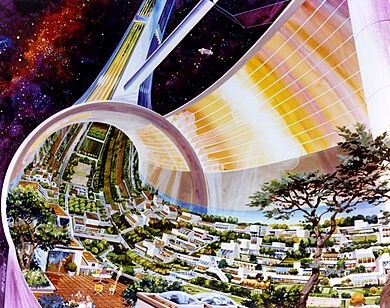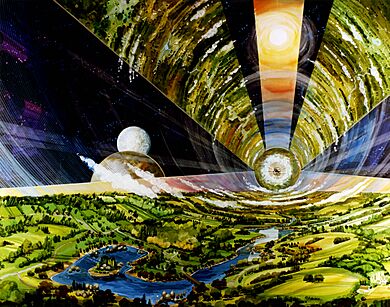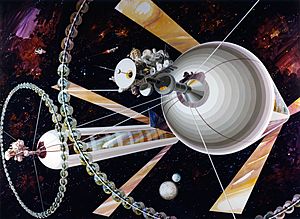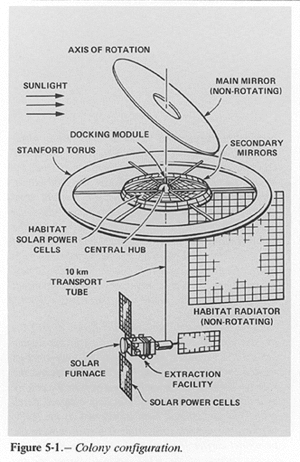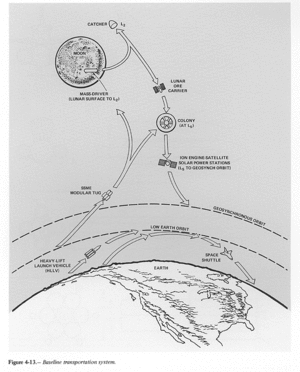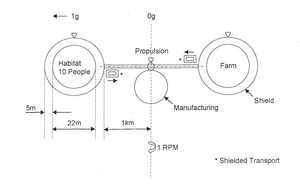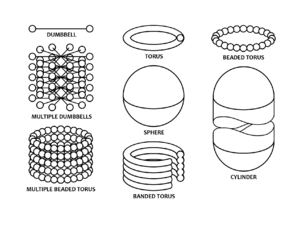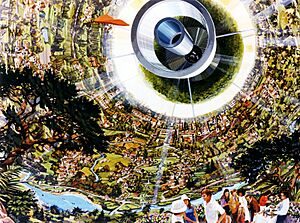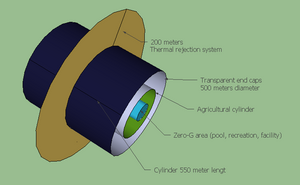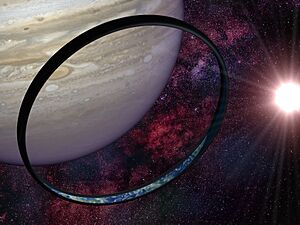Space settlement facts for kids
A space settlement is a place where people could live permanently in outer space. Think of it as a city or town built away from Earth. Unlike a regular space station or spacecraft, these settlements are designed for people to live and work there for a very long time, maybe even forever. They might even have their own closed ecological systems, which means they can recycle everything and grow their own food.
No space settlement has been built yet. But many ideas for them have appeared in science fiction stories. Scientists and engineers have also suggested designs that could actually be built one day.
Some space settlements would orbit around Earth or other planets. Others might be like giant ships traveling through space for a very long time, even for generations. These are sometimes called "world ships" or "generation ships."
Space settlements are a type of extraterrestrial settlement. This bigger group includes homes built on other planets or moons, like a moonbase, a Mars habitat, or even inside an asteroid.
Contents
What is a Space Settlement?
A space settlement is a big living area in space, usually orbiting a planet. It's more than just a place to visit; it's a place to live.
The International Astronautical Federation explains the difference between space habitats and settlements:
- Habitat: A sealed area where people live and work, with everything they need to survive.
- Settlement: A group of habitats that are lived in all the time, often connected to each other.
- Infrastructure: All the other things that support the habitats and settlements. This includes power plants, water systems, farms, and ways to get around.
Even though they are called "settlements," they are not automatically colonies. Some people, like scientist Carl Sagan, preferred the name "space city" instead of "space colony."
History of Space Settlements
The idea of living in space has been around for a long time. One of the first stories about a space home was "The Brick Moon" by Edward Everett Hale, written in 1869.
In 1903, a space pioneer named Konstantin Tsiolkovsky thought about spinning cylinder-shaped space homes. Later, in 1929, John Desmond Bernal imagined huge space settlements. In the 1950s and 1960s, Dandridge M. Cole suggested hollowing out asteroids and spinning them to create homes. He wrote about this in his book Islands In Space.
O'Neill's Ideas: The High Frontier
Around 1970, a physicist named Gerard K. O'Neill asked his students to figure out if large space settlements were possible. To his surprise, they found that even very big ones seemed doable! They imagined cylinders about 8 kilometers (5 miles) wide and 32 kilometers (20 miles) long, made from regular materials like steel and glass. The students also found ways to protect against space radiation, get natural sunlight, grow food, and control the settlement's position in space.
O'Neill wrote an article about these ideas in 1974. He then wrote a book in 1976 called The High Frontier: Human Colonies in Space.
NASA Studies in the 1970s
O'Neill's work led NASA to hold workshops to study these concepts further. They looked at designs that could hold from 1,000 to 10 million people. Some of the ideas included the Stanford torus, the Bernal sphere, and the Cylindrical Colony.
O'Neill suggested that these settlements could make money by building solar power satellites using materials from the Moon. He believed that once these factories started, they would find many ways to be profitable. The settlements could then become self-supporting and even build more settlements.
These studies created a lot of public excitement. It led to the creation of the L5 Society in the U.S. This group wanted to build and live in such space settlements. The "L5" in their name came from a special orbit (called a Lagrange point) that was thought to be a good place for space colonies.
Space Studies Institute
In 1977, O'Neill started the Space Studies Institute. This group helped fund and build early versions of equipment needed for space living. For example, they worked on a "mass driver." This machine could efficiently move materials, like moon rocks, from the Moon to space settlement orbits.
Why Build Space Settlements?
There are many reasons why people think building space settlements is a good idea:
- They could be bases for future space exploration.
- They could help reduce problems like too much industry or too many people on Earth.
- People could visit or live there for fun, like a space hotel.
- They could help the economy grow by using resources from space. This would avoid harming Earth's ecosystems.
- They could be places for humans to spread out and live independently.
- They could help human civilization survive if a big disaster happened on Earth.
Benefits of Space Settlements
Space settlements could offer many advantages:
Lots of Solar Energy
Space has a huge amount of sunlight. In Earth orbit, the Sun provides about 1400 watts of power per square meter. This energy can be used to make electricity from solar cells. It can also heat the settlements and provide light for plants to grow.
Easier Travel to Earth
It would be easier to trade between Earth and a settlement orbiting Earth than with a settlement on a planet like Mars. Settlements in orbit don't have a strong gravity well to overcome when sending things to Earth. It's also easier to bring things up from Earth.
Using Space Resources
Space settlements could get resources from places like Mars, asteroids, or the Moon. This is called in-situ resource utilization (ISRU). With ISRU, they could make breathing oxygen, drinking water, and rocket fuel. It might even be possible to make solar panels from lunar materials.
Asteroids and Small Bodies
Most asteroids have a mix of materials that could be mined. Since these space rocks don't have much gravity, it would be easy to take materials from them and move them to a construction site.
Some estimates suggest there's enough material in the main asteroid belt alone to build space settlements with a living area equal to 3,000 Earths!
More Living Space
An estimate from 1974 suggested that if all the material in the main asteroid belt were used, we could build enough habitats for trillions of people.
Fun in Zero Gravity
If a large area at the center of a spinning settlement is enclosed, people could enjoy zero-gravity sports. This could include swimming, hang gliding, or flying human-powered aircraft.
Travel to Other Worlds
A space settlement could be the living part of a huge spacecraft. This ship could travel to colonize asteroids, moons, or planets. It could also be a "generation ship" for very long journeys to other star systems.
What Space Settlements Need
Building a space settlement has many requirements. They would need to provide everything hundreds or thousands of people need to live. This must happen in space, which is a very harsh environment.
Rules and Governance
Having good rules and ways to govern space settlements is very important. Without them, living conditions could become unfair or dangerous.
High Starting Cost
Even the smallest settlement designs are much heavier than all the things humans have ever launched into Earth orbit combined. To build them, we need either much cheaper ways to launch things from Earth. Or, we need to set up mining and manufacturing on the Moon or other places where it's easier to get materials into space.
Location in Space
Scientists are still debating the best places for settlements to orbit. Some early ideas suggested orbits around the Moon's Lagrange points (L4 and L5). However, these are now thought to be too far from the Moon and Earth. A newer idea is to use an orbit that brings the settlement close to the Moon and then close to Earth. This would make it easier and cheaper to get raw materials and to trade with Earth.
Protection from Radiation
If a space settlement is at L4 or L5, it would be outside Earth's magnetic field for about two-thirds of the time. This would expose people to harmful radiation from the Sun and cosmic rays.
Settlements can be protected by using thick materials as a shield. Water or ice walls can block about half of the incoming radiation. Rock could also be used; about 4 metric tons of rock per square meter could reduce radiation to safe levels.
Scientists are also looking into "active shielding." This would use magnetic or electric fields to push away harmful particles. This could greatly reduce the amount of heavy material needed for shielding.
Atmosphere

Space settlements need air pressure, with the right amounts of oxygen (21%), carbon dioxide, and nitrogen (78%). Most designs imagine large, thin-walled containers that hold the air. Oxygen could come from moon rocks. Nitrogen is easiest to get from Earth, but it can also be recycled. It might also be found in ammonia from comets or moons in the outer Solar System.
The air inside a habitat could be recycled in many ways. One idea is to use plant gardens, perhaps with hydroponics (growing plants in water). However, plants don't remove all pollutants. Submarines, which are also closed environments, use special burners to clean the air.
Food Production
Space settlements would also need ways to produce food. At first, most food would have to come from Earth. But over time, recycling waste could reduce the need for imports. One idea is to burn waste and sewage to get carbon dioxide and water for farming. The minerals left over could be used as fertilizer.
Artificial Gravity
Living in zero gravity for a long time weakens bones and muscles. It can also cause other health problems. Most space settlement designs would spin around to create "fake" gravity using inertial forces. This is called Artificial gravity.
Studies show that people can get motion sickness if the settlement spins too fast or is too small. But if the settlement is large enough (over 500 meters in radius) and spins slowly (less than 1 rotation per minute), most people should feel comfortable.
Protection from Space Rocks
The habitat would need to be safe from impacts from space debris, meteoroids, and dust. Most meteoroids burn up in Earth's atmosphere. But in space, without a thick atmosphere, they pose a much bigger risk.
Radar systems would scan the space around the habitat to track debris. This would allow the settlement to move or take other actions to avoid being hit. Some designs include a thick shield of sand or rock (several meters thick) to protect against radiation and meteoroids.
Getting Rid of Heat
A space habitat in a vacuum is like a giant thermos bottle. It needs a way to get rid of heat from absorbed sunlight. This is done using a radiator. Smaller habitats might have a central fan that moves hot air towards the center and cool air down to the living areas. Other designs would use chilled water to carry heat away to a central radiator.
Staying Pointed Right
Most designs with mirrors need the habitat to be aimed at the Sun. So, they need a way to control their attitude (which way they are pointing). The original O'Neill design used the two cylinders as giant spinning wheels to help turn the colony.
Space Settlement Designs
Main Concepts
The two most common original ideas for space settlements are the Bernal sphere and the O'Neill cylinder.
Dumbbell-shaped Settlements
Imagine two habitats connected by a long cable, like a dumbbell. This design has been suggested for Mars ships or early space homes. It can spin slowly to create comfortable artificial gravity, even for a relatively small station. The main disadvantage is that for long-term living, the heavy radiation shield would also need to spin, requiring a very strong cable.
Some ideas suggest that small habitats could be built and then connected together. They could start as a single "bola" (two habitats spinning around each other), then grow into a "dumbbell," then a ring, and finally a cylinder of connected "beads." Each step would share more radiation shielding and equipment, making it safer and cheaper per person. This idea allows settlements to grow like cities on Earth, with smaller, step-by-step investments.
Other Concepts
- Island One: A Bernal sphere designed for about 10,000 to 20,000 people.
- Stanford torus: An alternative to Island One, shaped like a giant donut.
- Lewis One: A cylinder about 250 meters (820 feet) wide and 450 meters (1,476 feet) long. It has a non-spinning radiation shield.
- Island Three or O'Neill cylinder: A much larger cylindrical design, about 3.2 or 4 kilometers (2-2.5 miles) wide and 32 kilometers (20 miles) long.
- McKendree cylinder: An even bigger cylindrical design, using strong carbon nanotubes. Each cylinder would be 460 kilometers (286 miles) wide and 4,600 kilometers (2,858 miles) long!
- Kalpana One: A shorter cylinder, 250 meters (820 feet) wide and 325 meters (1,066 feet) long. It has a heavy radiation shield that spins with it and is designed for 3,000 residents.
- Bubbleworld or Inside/Outside concept: First thought of by Dandridge M. Cole in 1964. This idea involves drilling a tunnel through a large metal asteroid and filling it with water. Then, a huge solar mirror would heat the asteroid, making it soft. The water inside would expand, inflating the asteroid into a cylinder. Once cooled, it could be spun to create artificial gravity, and the inside filled with soil, air, and water.
- Asteroid terrarium: A similar idea to the bubble world, featured in the 2012 novel 2312 by Kim Stanley Robinson.
- Bishop Ring: A very large, speculative design using carbon nanotubes. It would be a ring 1,000 kilometers (621 miles) wide and 500 kilometers (311 miles) tall. It would be so big that its inner rim could be open to outer space.
Space Station Projects
Space settlements are like advanced space stations. So, new developments in space station building can help us learn how to build settlements.

The Lunar Gateway is a planned space station that will orbit the Moon. It will be the first space station built outside of Earth's low orbit. This means it will be the first spacecraft designed to operate in space without Earth's magnetic field protecting it.
The ISS once had a proposal for a "Centrifuge Demo" in 2011. This was meant to test a spinning compartment that could create artificial gravity. This test would help with building a similar module for a larger spacecraft called Nautilus-X. This larger vehicle would be for long missions, helping up to six crew members stay healthy for up to two years.
The Bigelow Commercial Space Station was announced in 2010. Bigelow showed designs for space stations with many inflatable modules, providing a huge amount of living space.
Space Settlements in Stories
Space settlements have appeared in many science fiction stories, books, and movies. For example, the movie Elysium (2013) showed a wheel-shaped Stanford torus. The movie Interstellar (2014) featured a cylindrical O'Neill cylinder type of settlement.
See also
- Arcology
- Bioastronautics
- Closed ecological system
- Domed city
- Dyson sphere
- Floating cities and islands in fiction
- Human outpost
- Locomotion in space
- Megastructure
- Planetary chauvinism
- Research station
- Space architecture
- Space observatory
- Space stations and habitats in fiction
- Spaceflight
- Space station
- Spome
- Underground living
- Underground city
- Underwater habitat
|


